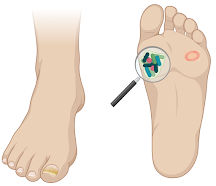Bad Nail Fungus!! Go Away

Nail fungus is better prevented than treated. Here's some advice on how to prevent fungal infections: Keep your toenails trimmed short, smooth edges and file down thickened areas. Sanitize your nail clippers. If you must wear socks, choose ones that wick moisture away from your skin. Choose shoes made of materials that breathe. Alternate your shoes regularly. Never wear someone else’s shoes or share nail clippers. Avoid going barefoot in public facilities. If you go to a nail salon for a pedicure, look around to make sure that staff are sanitizing tools. If you notice a problem with your nails, consult your doctor . Figure 1: Fungal infections of the Nail and Skin. Image created with Biorender.com.
